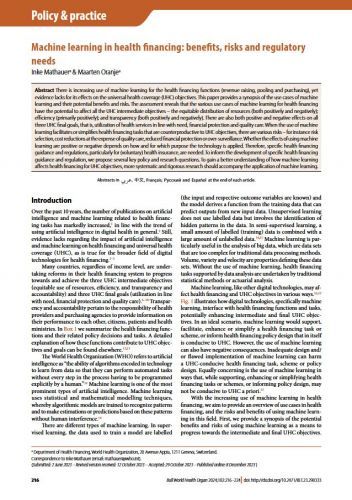
There is increasing use of machine learning for the health financing functions (revenue raising, pooling and purchasing), yet evidence lacks for its effects on the universal health coverage (UHC) objectives. This paper provides a synopsis of the use cases of machine learning and their potential benefits and risks. The assessment reveals that the various use cases of machine learning for health financing have the potential to affect all the UHC intermediate objectives – the equitable distribution of resources (both positively and negatively); efficiency (primarily positively); and transparency (both positively and negatively). There are also both positive and negative effects on all three UHC final goals, that is, utilization of health services in line with need, financial protection and quality care. When the use of machine learning facilitates or simplifies health financing tasks that are counterproductive to UHC objectives, there are various risks – for instance risk selection, cost reductions at the expense of quality care, reduced financial protection or over-surveillance. Whether the effects of using machine learning are positive or negative depends on how and for which purpose the technology is applied. Therefore, specific health financing guidance and regulations, particularly for (voluntary) health insurance, are needed. To inform the development of specific health financing guidance and regulation, we propose several key policy and research questions. To gain a better understanding of how machine learning affects health financing for UHC objectives, more systematic and rigorous research should accompany the application of machine learning. (AU)